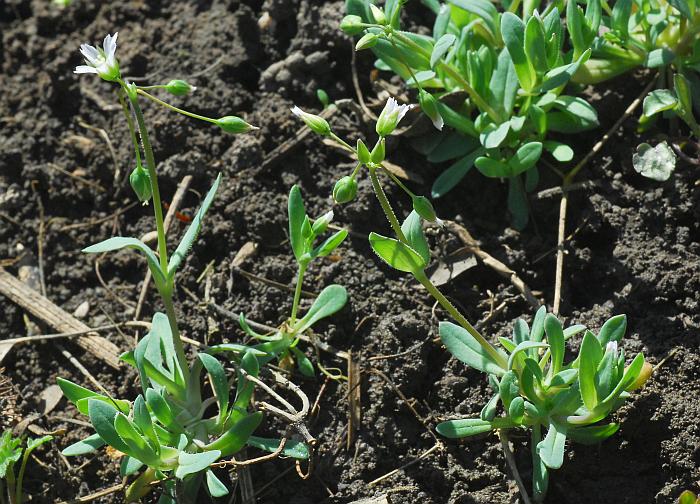Holosteum umbellatum L.
Jagged Chickweed

Introduced
CC = *
CW = 5
MOC = 50
© SRTurner
Holosteum umbellatum L.Jagged Chickweed | |
 |
Introduced CC = * CW = 5 MOC = 50 |
© SRTurner |
|
Family - Caryophyllaceae Habit - Annual forb.
Stems - Ascending to erect, to 35 cm, unbranched or branched at the base, glabrous or sparsely to moderately pubescent with short, stalked glands, especially toward the base.
Leaves - Basal and opposite. Basal leaves short-petiolate, the blades 0.2-3.0 cm long, oblanceolate to narrowly oblanceolate. Stem leaves sessile, fused basally into a sheath, elliptic to ovate or lanceolate, somewhat thickened and sometimes slightly succulent, tapered to short-tapered at the base, angled or tapered to a sharply pointed tip.
Inflorescence - Terminal, long-stalked umbels, the stalks 0.5-2.5 cm long, ascending to spreading at flowering, becoming downward-angled from the base after flowering, and becoming erect or ascending again at maturity of the fruit, the bracts whorled, minute, herbaceous with thin, translucent margins to completely papery and white to translucent.
Flowers - Sepals 5, 2.5-4.5 mm long, distinct, lanceolate to ovate, angled to a bluntly or sharply pointed tip, the margins thin and white to translucent. Petals 5, 3-5 mm long, oblanceolate to spatulate, tapered to a stalklike base, irregularly toothed or shallowly several-lobed at the tip, white. Stamens 3-5, the filaments distinct. Pistil with 1 locule, sessile. Styles 3, each with the stigmatic area subterminal or along the inner surface.
Fruits - Capsules, 4-8 mm long, opening by usually 6 outward-curled teeth. Seeds 35-60, 0.5-1 mm long, oblong, flattened, the surface appearing pebbled or with broad, low papillae, orange to brown, lacking wings or appendages.
Flowering - March - May. Habitat - Glades, dry forest openings, bluffs, lawns, fields, railroads, open disturbed areas. Origin - Native to Eurasia. Lookalikes - Small species of Cerastium and Draba. Other info. - This small and inconspicuous plant is easily recognized by its jagged white flower petals, and by its peculiar habit of orienting its flowers upward, immature fruits downward, and mature fruits upward. This latter behavior gives the plants a very distinctive appearance. The species is found across the southern 2/3 of Missouri, and in several regions across the U.S. Photographs taken at Matson Hill County Park, St. Charles County, MO, 3-14-2012, Weldon Spring Conservation Area, St. Charles County, MO, 3-15-2016, Marais Temps Clair Conservation Area, St. Charles County, MO, 4-9-2019, and near Labadie, MO, 4-10-2019 (SRTurner). |